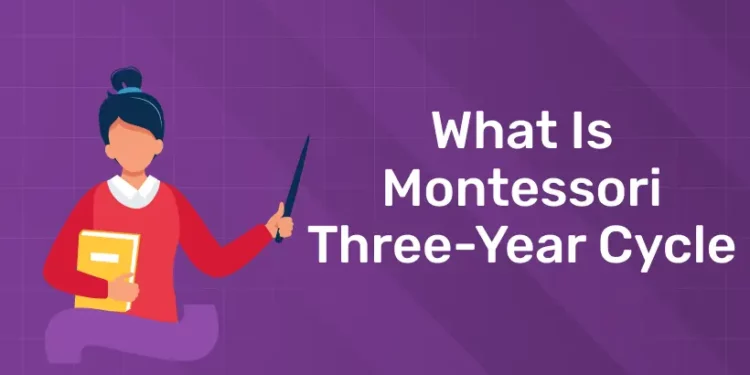Table of Contents
A key idea in Montessori education is the three-year cycle, which emphasizes the value of multi-age groups and a three-year window for each developmental stage. In this blogpost we are disscussing in detail about the Montessori Three-Year Cycle.
Start your journey to becoming a certified Montessori teacher! Get free Demo Here!
What is a Montessori Three-Year Cycle?
According to Montessori, kids usually start as the youngest students in a classroom and remain in the same learning community for at least three years. They go through a growth and development cycle throughout the course of those three or so years.
When kids first enter a new classroom, it’s similar to what happens when you move a perennial flower; they don’t initially exhibit much growth on the outside and need some time to establish their roots. Children are examining their surroundings and figuring out their new community during their first year in school.
Children are more mature and, similar to perennial flowers, tend to expand and bloom a little more during their second year. This is the period of time when kids are experimenting in a safe and secure learning environment.
By the time they reach their third year, they are the community’s experts. Children grow exponentially and abundantly, just like perennial flowers do. They really do bloom. The kids who have profited from a three-year cycle demonstrate what happens when kids are given the chance to take root, grow, and then have the time and space to blossom in novel and fascinating ways.
Importance Of Three Year Cycle
1: What is the primary focus of the first plane of development in the Montessori method?
Building Community
Children can lay a foundation that benefits them in many ways by living in a stable community for at least three years. Children not only have time to perfect a skill, but they also build enduring relationships with adults and their classmates.
Montessori teachers are skilled in recognizing the unique learning styles, rhythms, and demands of each child because of their training and awareness of developmental needs. They are able to customize their presentations for each child, knowing just when and how to encourage them to step outside of their comfort zones. Children can feel safe enough to take chances in their education as a result.
Changing Roles
As kids grow up together in a household, the kids become like siblings. While the older kids gain self-assurance and leadership abilities and serve as mentors and role models for the younger kids, the younger kids watch and learn from the older kids. Students’ self-esteem is bolstered and a gradual sense of responsibility, accomplishment, and independence is instilled in them by this social, educational, and interactive environment.
Pursuing interests and Developing abilities
Through each three-year cycle, Montessori teachers support and encourage children to explore and exercise their interests and abilities at their own pace, laying the groundwork for knowledge advancement and the social skills development of young people in a dynamic, exciting environment. Before going on to the next level, the curriculum and resources for each age group are made to give kids the tools they need to learn and become proficient in novel and difficult tasks.
Unlock your passion for education and shape young minds as a Montessori teacher!
Get Certified & Start Your Montessori Career
Montessori Teacher Training Course by Entri App: Gain expert skills, earn certification, and kickstart your teaching career.
Join Now!Development Planes Of Montessori Three Year -Cycle
Explorers
The “explorers,” or first-year students, are usually three-year-olds with the need to gain self-sufficiency and investigate their surroundings. As kids develop their senses, absorb order, learn to sort and categorize, and exercise concentration—skills that are fundamental to thinking and learning—the Montessori classroom becomes their world to explore. Three-year-olds’ natural need for independence is nourished in Montessori classrooms, where they acquire the knowledge and resources necessary to take care of themselves in their surroundings. They travel freely, pursuing their own interests and developing at their own speed. They acquire the ability to accept accountability for both their own actions and their output, which helps them form the positive work habits that will enable their
Experimenters
The second-year students or “experimenters” , who are usually four years old. After spending a year exploring and focusing on themselves, they are now expanding their attention to include their peers and the school community. Their natural inclination is to study group dynamics and engage in social interaction practice. Along with starting more teacher-directed activities and working mostly in small groups rather than alone, they continue to hone their autonomous work habits.
Experts
“The experts,” or third-year students, are usually five years old. These kids can work fully independently and have a solid foundation in every area of the classroom. Both academically and socially, they are developmentally equipped to take on leadership roles and serve as peer educators. As kids take ownership of their education, they continue to hone their diligent work habits. These kids are capable of handling a new environment when they enter primary school because they are self-assured, imaginative thinkers, and problem solvers.
CONCLUSION
Using mixed-age groups, individualized instruction, and a safe, nurturing environment, the Three-Year Cycle—a cornerstone of Montessori education—aims to support children’s natural growth. Kids that follow this approach are better prepared for success and lifelong learning since they develop not only intellectually but also socially, emotionally, and personally.
Get Certified & Start Your Montessori Career
Montessori Teacher Training Course by Entri App: Gain expert skills, earn certification, and kickstart your teaching career.
Join Now!Frequently Asked Questions
Is the Three-Year Cycle used in all Montessori schools?
The Three-Year Cycle is a fundamental component of Montessori education and is used in the majority of real Montessori institutions. However, depending on the school and the unique needs of the community, implementation may differ differently.
How does the Three-Year Cycle support social development?
The mixed-age environment promotes social contact, empathy, and cooperation. Over the course of the three years, children learn how to collaborate, support one another, and form solid social relationships.
Why is the Three-Year Cycle important in Montessori education?
Through interactions between students and teachers of different ages, the Three-Year Cycle fosters social growth through tailored learning and offers a secure and predictable learning environment.
How does the relationship between teacher and student benefit from the Three-Year Cycle?
Over the course of three years, teachers get a thorough awareness of each child’s strengths, interests, and requirements, which enables more individualized and effective instruction. Between the teacher and the student, this long-term relationship also fosters communication and trust.











